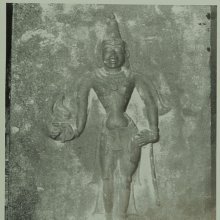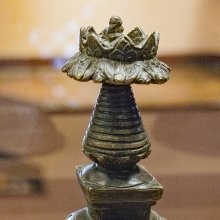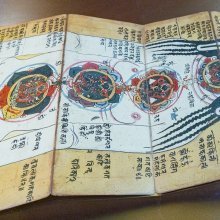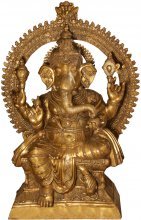Lotus petal: 1 definition
Introduction:
Lotus petal means something in Hinduism, Sanskrit. If you want to know the exact meaning, history, etymology or English translation of this term then check out the descriptions on this page. Add your comment or reference to a book if you want to contribute to this summary article.
Images (photo gallery)
(+5 more images available)
In Hinduism
Shilpashastra (iconography)
Source: Shodhganga: Elements of Art and Architecture in the Trtiyakhanda of the Visnudharmottarapurana (shilpa)The Petal of a Lotus is denoted by the Sanskrit term Padmapatra, and represents one of the five kinds of Eyes, which follows specific guidelines of ancient Indian Painting (citra), according to the Viṣṇudharmottarapurāṇa, an ancient Sanskrit text which (being encyclopedic in nature) deals with a variety of cultural topics such as arts, architecture, music, grammar and astronomy.—In the Viṣṇudharmottarapurāṇa also, different kinds of eyes and their particular shapes are elaborately discussed in the context of Painting. The forth variety of eye should be in the shape of padmapatra i.e., petal of lotus flower and the size should be nine yavas. In the Kumārasambhava, Pārvatī is referred to utpalākṣyā i.e., one with the eyes in the shape of utpala i.e., lotus. The Viṣṇudharmottarapurāṇa states that the eyes of the scared and lamenting person should be in the shape of lotus petal.

Shilpashastra (शिल्पशास्त्र, śilpaśāstra) represents the ancient Indian science (shastra) of creative arts (shilpa) such as sculpture, iconography and painting. Closely related to Vastushastra (architecture), they often share the same literature.
See also (Relevant definitions)
Partial matches: Lotus, Petal.
Full-text (+163): Dala, Padmapatra, Kamaladalakodati, Aravimdanetra, Kamjapatrambake, Utpalapattranila, Aravimdanetre, Abjadalanetre, Kuvalayadala, Niladala, Dalanila, Marudesha, Viraja, Elapura, Kshirika, Erudika, Mayapuri, Hala, Rajapuri, Vamavarta.
Relevant text
Search found 63 books and stories containing Lotus petal; (plurals include: Lotus petals). You can also click to the full overview containing English textual excerpts. Below are direct links for the most relevant articles:
Garga Samhita (English) (by Danavir Goswami)
Verse 2.16.33 < [Chapter 16 - The Worship of Tulasī]
Verse 4.4.3 < [Chapter 4 - The Story of the Kauśalā Women]
Verses 5.15.13-15 < [Chapter 15 - Seeing Sri Radha]
Jainism in Odisha (Orissa) (by Ashis Ranjan Sahoo)
Jaina Temples at Subei (Koraput) < [Chapter 3: Survey of Jaina Antiquities in Odisha]
Jaina Antiquities at Purunagarh (Koraput) < [Chapter 3: Survey of Jaina Antiquities in Odisha]
Jaina images of Charmula < [Chapter 3: Survey of Jaina Antiquities in Odisha]
Stupas in Orissa (Study) (by Meenakshi Chauley)
Minor Structural Stupas at Udayagiri (Western Zone) < [Chapter 4]
The Chatravali Portion (of the Stupa) < [Chapter 4]
Minor Structural Stupas at Udayagiri (Southern Zone) < [Chapter 4]
Mahabharata (English) (by Kisari Mohan Ganguli)
Section CLXXIV < [Caitraratha Parva]
Section XXV < [Asramavasa Parva]
Section LXVII < [Bhagavat-Gita Parva]
Bhakti-rasamrta-sindhu (by Śrīla Rūpa Gosvāmī)
Verse 2.3.55 < [Part 3 - Involuntary Ecstatic Expressions (sattvika-bhāva)]
Verse 3.5.18 < [Part 5 - Conjugal Love (mādhurya-rasa)]
The Soul and The Universe < [October - December 1975]
Patriot’s Lyre < [April – June and July – September, 1996]
The All-Pervading < [July – September, 1990]





